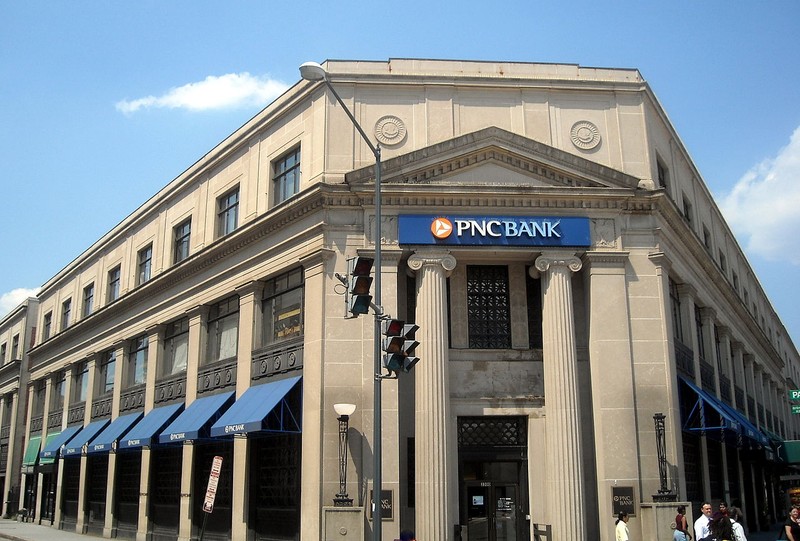Riggs-Tomkins Building
Introduction
Text-to-speech Audio
The Riggs-Tomkins Building was built in 1922 by the now-defunct Riggs Bank, which PNC Bank acquired in 2005. Riggs was established in 1840 and became one of the city's most prestigious banks, used by over 20 presidents including Abraham Lincoln and Dwight D. Eisenhower (for this reason it earned the nickname "the bank of presidents"). The building was one of Rigg's first branch locations. In 1923, it became home to the first location of the WRC radio station, which is the oldest, continuously operating radio station in the city and is now known as WTEM. The building is also named for builder, businessman and engineer Charles Hook Tompkins, who specialized in reinforced concrete construction and erected around 500 buildings in the city by the early 1930s. An excellent example of Classical Revival architecture, the Riggs-Tomkins Building was added to the National Register of Historic Places in 1987.
Images
Riggs Bank, which was once Washington D.C.'s leading financial institutions, built the historic Riggs-Tomkins Building in 1922. It was one of the bank's first branches in the city. The bank held the accounts of many presidents and as a result, earned the nickname "the bank of presidents."

Backstory and Context
Text-to-speech Audio
The history of Riggs Bank dates back to 1836 when William Corcoran established an exchange and banking house in Washington D.C. George Washington Riggs became Corcoran's partner in 1840 and together the two men established the bank as Corcoran & Riggs. As noted above, it was used by many presidents, beginning with President Martin Van Buren who served form 1837 to 1841. In 1847, the bank lent the federal government $15 million to help finance the U.S. war effort during the Mexican-American War (1846-1848). In 1867, it granted the federal government $7.2 million in gold to buy Alaska from Russia. The bank is also notable for lending money to Samuel Morse in 1848 to help him invent the telegraph and for financing explorer Robert Peary's first expedition to the North Pole in 1886.
The bank continued to grow and play an important role in Washington over the next several decades. In 1891, the bank constructed a new building that is now the Riggs Washington D.C. hotel. Five years later it renamed itself as "Riggs National Bank" and the last Riggs family member resigned in 1898. In 1909, the bank proposed a plan to the federal government to create the Federal Reserve banking system, which was established in 1913. In 1922, Riggs acquired the failing Hamilton Savings Bank, which was experiencing significant difficulties at the time. The acquisition enabled Riggs to expand its business in the northwest part of the city, which included building two new branches. The Riggs director served as an adviser to President Roosevelt during the Great Depression, and during the World War II, the bank sold over $230 million bonds.
The Radio Corporation of America, which established the WRC station, chose the Riggs-Tomkins Building for its elevated location and built a two 100-foot radio towers on the roof. WRC's first broadcast occurred on August 1, 1923 and it was the first to broadcast a presidential address. The building also housed radio equipment stores, a service center, and a radio school. WRC remained at the building until the 1950s. It became WTEM in 1998 and is now a sports station.
Rigg's demise came in the wake of three money laundering scandals. One was for financing two of the Saudi 9/11 hijackers through a bank account of the Saudi ambassador's wife. Another was for laundering money to the dictator of the Equatorial Guinea through the country's bank account. The third was allowing the former dictator of Chile, Augusto Pinochet, to open an account at the bank. These activities came to light in the early 2000s and Rigg's reputation and business dropped significantly. It became clear it could no longer operate and was sold to PNC Bank.
Sources
"At Riggs Bank, a Tangled Path Led to Scandal." Times Daily. July 19, 2004. Last Updated May 1, 2013. https://www.timesdaily.com/archives/at-riggs-bank-a-tangled-path-led-to-scandal/article_b6bdb37d-0af9-5a1f-a260-7aeb39586973.html.
Carter, Elliot. "Riggs Bank." Atlas Obscura. December 15, 2016. https://www.atlasobscura.com/places/riggs-bank-the-bank-of-presidents.
Closs, Christopher W. "Riggs-Tomkins Building." National Park Service - National Register of Historic Places Nomination Form. January 5, 1987. https://npgallery.nps.gov/GetAsset/de77855b-78ff-44dc-b81b-ee5272d88534.
"PNC-Riggs Bank Records." Special Collections Research Center, Gelman Library, The George Washington University. Accessed October 24, 2022. https://searcharchives.library.gwu.edu/repositories/2/resources/365.
"Riggs Bank." Riggs Washington D.C. Accessed October 25, 2022. https://www.riggsdc.com/about/history.
White, Thomas H. "Washington, D.C. AM Station History." January 1, 2022. https://earlyradiohistory.us/hist-dc.htm.
Wikimedia Commons: https://commons.wikimedia.org/wiki/File:Riggs-Tompkins_Building.jpg
